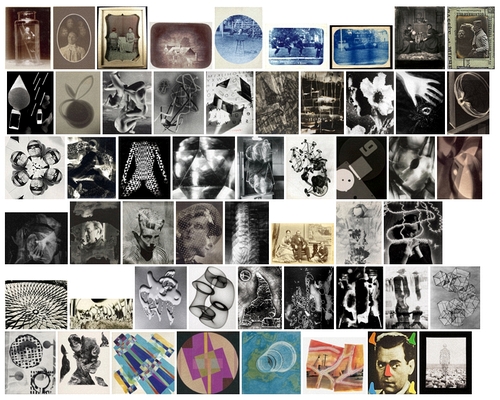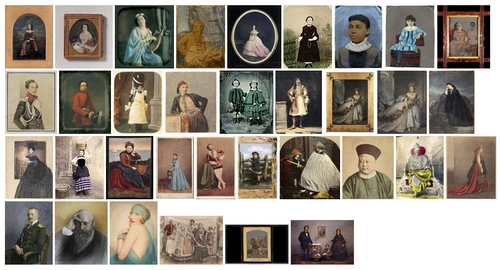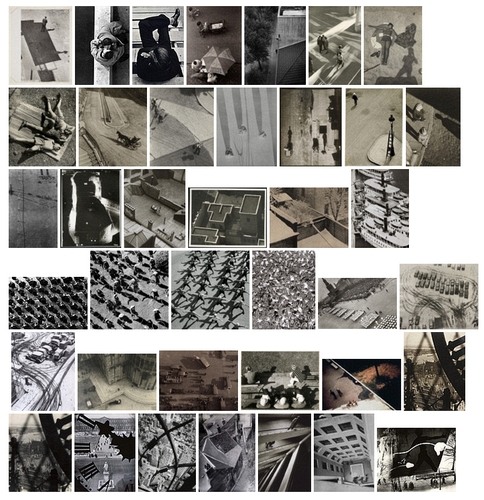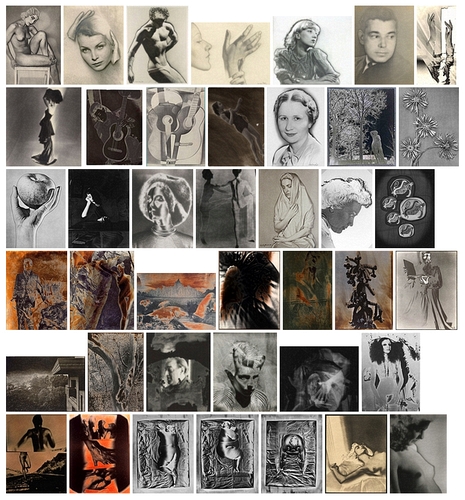Welcome to another Luminous-Lint Newsletter.
To all Luminous-Lint subscribers and contributors I'd like to say thanks as we progress. All the best, Alan
Experimental and Manipulated Photography |
Luminous-Lint has a vast range of examples and resources to explore on "Experimental and Manipulated Photography." It starts with the rare early use of multiple exposures by Daguerreian photographers and the use of multiple negatives to include clouds of seascapes by Gustave Le Gray.
Sections on "Trick photography" include:
Bust or statuette portraits
Multiple portraits taken using mirrors (Multigraphs or mirror portraits)
Decapitated heads
Spirit photography
Reduction
People in bottles
Photo caricatures
Photograms of seaweed
Stamps
Electrical photographs
Crayon daguerreotypes and vignettes
The simulation of night
There are numerous examples of each of these as albumen prints, cyanotypes and gelatin silver prints. Wherever possible original patents and other sources outlining the processes are included.
Visual Indexes such as the one below illustrate each of the different types of manipulation.

Alan Griffiths, 10 April 2018, Luminous-Lint screenshot showing part of the visual index for "Experimental and manipulated photography", Screenshot
LL/81964
The use of composite photographs has been employed in portraiture to combine groups of multiple individuals into a single image intended to capture the characteristics of the group as a whole.
Francis Galton (1822-1922), a Victorian polymath and founder of eugenics, used composites and described them in his book Inquiries into Human Faculty (1883) as follows:
The accompanying woodcut is as fair a representation of one of the composites as is practicable in ordinary printing. It was photographically transferred to the wood, and the engraver has used his best endeavour to translate the shades into line engraving. This composite is made out of only three components, and its threefold origin is to be traced In the ears, and in the buttons to the vest. To the best of my judgment, the original photograph is a very exact average of its components; not one feature in it appears identical with that of any one of them, but it contains a resemblance to all, and is not more like to one of them than to another. However, the judgment of the wood engraver is different. His rendering of the composite has made it exactly like one of its components, which it must be borne in mind he had never seen. It is just as though an artist drawing a child had produced a portrait closely resembling its deceased father, having overlooked an equally strong likeness to its deceased mother, which was apparent to its relatives. This is to me a most striking proof that the composite is a true combination.
The technique was also used by Arthur Batut, who is better known as a pioneer of kite photography. Periodically composite portrait techniques are "rediscovered" and examples can be seen in the work of Nancy Burson, Philippe Halsman and Ken Kitano. With digital processing it has become easier and now many thousands of portraits can be combined to create a single composite.

Alan Griffiths, 10 April 2018, Luminous-Lint screenshot showing part of the visual index for "Composite and combination prints: Portraits", Screenshot
LL/81965
From the earliest days of photography people have experimented with painting on photographs. We can find examples of painted daguerreotypes, salt prints, albumen prints and all other types. Painted photographs are widely scattered in collections around the world and on Luminous-Lint the finest are bought together for study.

Alan Griffiths, 10 April 2018, Luminous-Lint screenshot showing part of the visual index for "Painting on photographs", Screenshot
LL/81966
Fairground mirrors were used to take photographs and André Kertész exploited their visual possibilities. Finding well-sourced examples can be difficult and Luminous-Lint brings them together from diverse collections.

Alan Griffiths, 10 April 2018, Luminous-Lint screenshot showing part of the visual index for "André Kertész: Distortions", Screenshot
LL/81967
The selection of the camera, lens, tilt and shot angles can all create unusual ways of seeing and patterns where they were not intended. It is difficult to imagine the effect of the first tethered balloon camera shots would have had upon a public that had never had the ability to see the world from above. Looking down on a person from an unconventional viewpoint may create a sense of unease - the viewer is a voyeur participating in a secret moment.

Alan Griffiths, 10 April 2018, Luminous-Lint screenshot showing part of the visual index for "Viewpoints: Looking down", Screenshot
LL/81971
The rediscovery of solarization by Man Ray and Lee Miller was ideal for Surrealism. Surrealism has been such a significant part of twentieth century art that it is well explored and the emphasis on Luminous-Lint is upon photography rather than literature, poetry, painting and cinema. Surrealism started as a literary form in the late 1910s and early 1920s as a means of opening the mind to the imagination and accessing the subconscious through automatic writing. The key to understanding is to see the range of experimentation and this is where Luminous-Lint excels.

Alan Griffiths, 10 April 2018, Luminous-Lint screenshot showing part of the visual index for "Solarization", Screenshot
LL/81972
There are numerous books on Man Ray and several of those concentrate on his Rayograms. Having access to key images is critical and Luminous-Lint provides a wide range by artists who experimented with similar techniques including Anna Atkins (1799-1871), Herbert Bayer (1900-1985), Sarah Anne Bright (1793-1866), Roger Catherineau (1925-1962), Alain Gerard Clement, Julien Coulommier (1922-), Susan Derges (1955-), Johann Carl Enslen (1759-1849), Lois Field• Adam Fuss (1961-), Len Gittleman, Hajicek & Panaro-Smith, Levett Landen Boscawen Ibbetson (1799-1869), Lotte Jacobi (1896-1990), Bertha Jaques, William Keck, György Kepes (1906-2001), Edmund Kesting (1892-1970), Myron Kozman, Lou Landauer (1897-1991), Lou Landauer (1897-1991), Herbert Matter (1907-1984), László Moholy-Nagy, Harry Nankin (1953-), Oskar Nerlinger (1893-1969), Floris M. Neusüss (1937-), Pablo Picasso (1881-1973), Max Pritikin, Edward Quigley (1898-1977), Isaac A. Rehn (1815-1883), Rosa Rolanda (1895-1970), Christian Schad (1894-1982), Werner Schnelle (1942-), Bernard Siegel, Fritz Simak and Anna K. Weaver.
Some of these artists are obscure but deserve to be included in any decent history of photograms.

Alan Griffiths, 10 April 2018, Luminous-Lint screenshot showing part of the visual index for "Man Ray: Rayograms", Screenshot
LL/81968
The influence that the cut-paper abstractions of Francis Bruguičre had upon Frederick Sommer is unclear but visual comparisons assist in our understanding. So there is a Visual Index on Luminous-Lint of the little-known abstractions of Bruguičre.

Alan Griffiths, 10 April 2018, Luminous-Lint screenshot showing part of the visual index for "Francis Bruguičre: Cut-paper abstractions", Screenshot
LL/81969
There are related subjects such as the Vorticist works of Alvin Langdon Coburn and the use of visual metaphors such as the "Equivalents" of Alfred Stieglitz. Each of these explored visual abstraction and metaphor with Coburn stating:
...why should not the camera throw off the shackles of conventional representation and attempt something fresh and untried? Why, I ask you earnestly, need we go on making commonplace little exposures of subjects that may be sorted into groups of landscapes, portraits, and figure studies? Think of the joy of doing something which it would be impossible to classify, or to tell which was the top and which the bottom! (Alvin Langdon Coburn, 1916, "The Future of Pictorial Photography", Photograms of the Year 1916)

Alan Griffiths, 10 April 2018, Luminous-Lint screenshot showing part of the visual index for "Alfred Stieglitz: Equivalents", Screenshot
LL/81970
Finally I'd like to recommend Mia Fineman's splendid 2012 book Faking it: Manipulated Photography before Photoshop, (New York: The Metropolitan Museum of Art) as it is full of excellent examples.
Hints for Subscribers
- There are diverse Themes on "Experimental and Manipulated Photography" and these are accessible on the "Contents" page.
- Try the Connections dropdown menu and type in "photogram" or "distortion" "and you'll find masses of examples.
- When you are logged in remember to use the "Contextualize" option under each image as it will show you a host of connections.
If you have any questions send me an email at alan@luminous-lint.com
So who has been involved in Luminous-Lint to date? |
Given the scale of Luminous-Lint it is difficult to remember all the names of those who have helped in ways both large and small. Having said that one should always try so I‘ve added an "Acknowledgements" page to get the ball rolling. As you go through it you will get a sense of the truly international scope of this project. Still a long way to go but we move forward with all your help. My gratitude to all the subscribers and to all of you joining in.
Free Trial of Luminous-Lint |
A FREE TRIAL for the website is currently available so send an email to alan@luminous-lint.com with your name and reasons for wanting to take a look and I'll set up a password for you.
  
Educational subscriptions |
It is time to ensure that your subscription to Luminous-Lint has been confirmed. Please check with whoever manages subscriptions to digital resources to ensure all is well. If you are a professor, researcher or student requiring access to Luminous-Lint please contact your head of department or librarian.
If you need any assistance with curriculum planning or resources to supplement your courses send me an email.

Luminous-Lint is under continual revision and adding in some of the Nelson-Atkins Museum of Art photographs has enhanced the following Themes. If you have suggestions for subjects that should be added please let me know.
Abstraction of light
Abstraction of the real
Abstract
Agricultural and pastoral
Air transportation
Airplanes
Architecture
Artist studies - Académies
Art
Astronomy
Avant-garde
Backgrounds and foregrounds
Back
Birds
Botany
California
Camera obscura
Cameraless photographs
Cars
Children
Cityscapes - Urban
Civil engineering
Clouds
Composite and combination prints
Composite portraits
Composition
Crime and punishment
Daguerreotypes
Documentary
Domesticated animals
Drawing and optical devices
Equivalents, similes and visual metaphors
Erotica and nudes
Experimental and manipulated photography
FSA - Farm Security Administration
Family life
Fashion
Feet
Flora
Flowers
France
Gelatin silver prints
Great Depression
Hand-painted photographs
Hands
Humour
Hungary
Ice and snow
Illinois
Industrial
Instantaneous photography
Interiors of photographic studios
Ireland
Italy
Land transportation
Landscape
Lines and shapes
Modernism
Movement and motion
Musicians
New Bauhaus / Art Institute of Chicago
New York School of Photography (1930s-1960s)
New York
Night
Occupational
Occupations and roles
Painting on photographs
Paris
Parts of the body
Photograms
Photographers
Photographic studios
Photomicroscopy
Photomontage
Post-modernism
Poverty
Railways
Representations of people
Rooms and their contents
Scientific
Self-portraits
Shadows
Signage
Solarization
Sports
Staircases
Still life
Street: Classic French examples
Street
Surrealism
Text and calligraphy
Trees
USA
Urban life
Using different viewpoints
Weather
Women photographers
|
|

